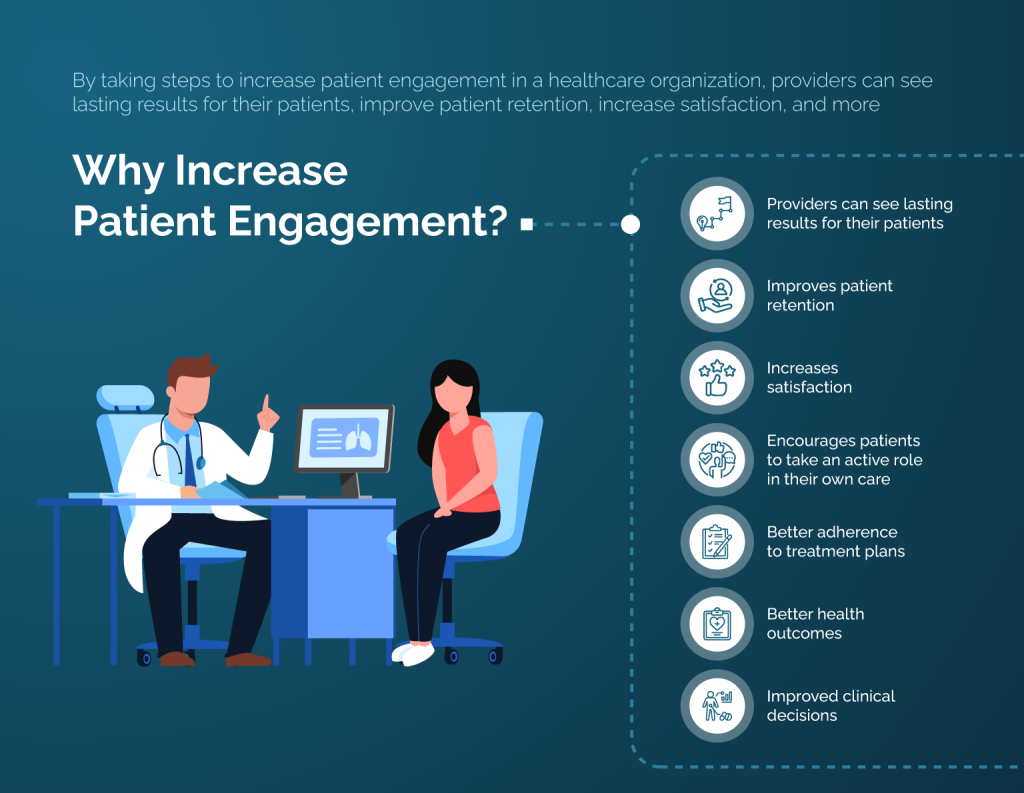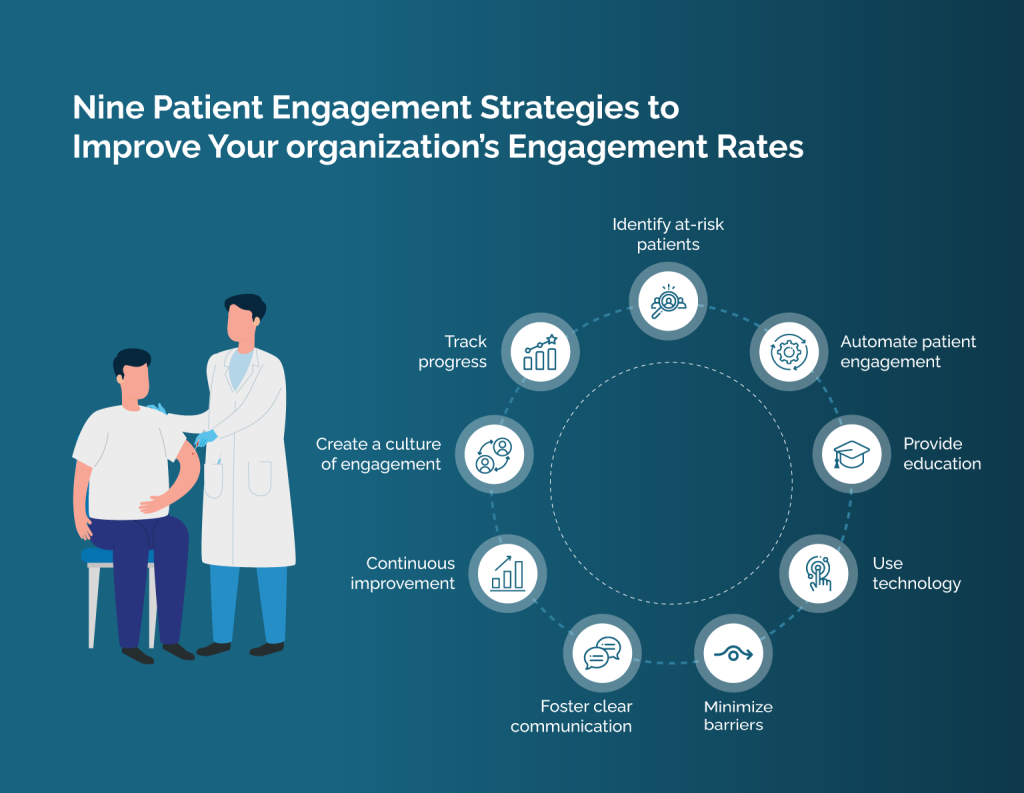The Definitive Guide to Increase Patient Engagement in 2023

Learn how to increase patient engagement at your healthcare organization in 2023 with this guide.
By taking steps to increase patient engagement in a healthcare organization, providers can see lasting results for their patients, improve patient retention, increase satisfaction, and more. Learn more about what patient engagement is and its importance, as well as nine of the best patient engagement strategies that can improve your organization’s engagement rates.
Jump ahead: 9 Best Strategies to Increase Patient Engagement
- Identify At-Risk Patients
- Automate Patient Engagement
- Provide Education
- Use Technology
- Minimize Barriers
- Foster Clear Communication
- Provide a Pathway for Continuous Improvement
- Create a Culture of Engagement
- Track Progress
What is Patient Engagement?
Patient engagement refers to the patient’s level of active involvement in their own healthcare journey. Examples of active engagement include: maintaining appointments, managing chronic conditions, asking questions, participating in treatment decision-making, and adhering to treatment plans.
Despite what the phrasing may suggest, patient engagement isn’t one-sided. Healthcare professionals play a crucial role in this strategy as well. This includes educating patients about their conditions and involving them in the decision-making process. Providers should also take steps to identify any sticking points in the patient journey that may affect patient engagement.

Why is Patient Engagement in Healthcare Important?
High levels of patient engagement benefit both patients and providers.
Patient Engagement and Patient Outcomes
On the patient side, higher levels of engagement result in improved health outcomes. Patients who routinely attend visits and share their concerns and needs to their providers are more likely to understand and follow treatment plans.
As a result, better health outcomes also reduce the need for further medical treatment. This allows patients to save money on healthcare costs.
Additionally, when patients feel more involved in their care, they report higher levels of satisfaction with their healthcare experience.
Patient Engagement and Healthcare Providers
Healthcare providers are also able to make better clinical decisions when their patients engage in their own care. By involving patients in the decision-making process, healthcare providers can make more informed choices. These choices can lead to better health outcomes, strengthen the patient-provider relationship and improve patient retention.
For clinical care to be truly effective in any practice, however, it involves the participation of both the patient and healthcare providers.

Understanding the Patient Journey: When Does Patient Engagement Begin?
Patient engagement starts long before the patient meets with a provider or steps into a medical practice. Put yourself in your patient’s shoes to help make sense of the patient’s journey. Doing so can help you and other members of the care team identify areas to improve engagement.
Before the Visit
If you consider the check-in process for an appointment the first step of the patient journey, you’re already behind schedule with patient engagement. By the time a patient engages with their providers, they’ve likely interacted with your practice a number of times. This includes the initial scheduling of the visit, intake forms, appointment reminders, and copays, to name just a few.
Identifying any gaps or sticking points in this process is a crucial first step in learning how to increase patient engagement.
During the Visit
In an optimal scenario, providers are able to engage patients to improve the patient’s health during the visit. Patient engagement activities can include:
- Educating patients on their conditions and treatment options
- Creating open communication and encouraging patients to ask questions and voice concerns
- Involving patients in the decision-making process of their care
- Assisting patients in setting goals and creating action plans
- Promoting patient autonomy and encouraging participation in their own care
- Providing patients with resources and tools for self-management
After the Visit
Aftercare is a crucial element of post-visits. One study showed that 4 in 10 patients misunderstand or ignore aftercare instructions. This is a patient engagement benchmark that every healthcare practice should consider.
The final step in the patient journey often involves payment collection as well. This involves important questions such as: How easy is it for a patient to make a payment? How soon after services are rendered is a payment request sent? As the consumerization of healthcare rises, can patients pay with their preferred methods? How can A.I. or other innovative technologies simplify this process?
[RELATED: Webinar on How to Automate Patient Payments Before & After the Visit.]

9 Best Strategies to Increase Patient Engagement
Here are nine strategies in healthcare that can help get patients more involved in their care and increase patient engagement.
Identify At-Risk Patients
Early identification of at-risk patients allows healthcare providers to proactively reach out and engage with these patients. This can enable healthcare teams to understand patient concerns and address any barriers they may have.
Knowing which patients are at risk for no-shows can also allow healthcare providers to tailor their engagement efforts. This helps providers to better meet the specific needs of these patients. At Mend, we realize some patients are more prone to miss appointments than others. What if you could move those patients to telemedicine where no-show rates average in the single digits for Mend customers?
Automate Patient Engagement
Automating different steps of the patient journey can help engage patients early on in their care. Artificial intelligence and other innovative technologies are excellent ways to improve the patient experience and therefore increase patient engagement.
Some of these include patient self-scheduling, digital forms, the automatic collection of copays, and self-check-in.
Provide Patient Education
A certain degree of health literacy is necessary to increase patient engagement. When patients better understand their health, you equip them with the knowledge to make better decisions. One study revealed that patients were more compliant (67%) with their treatment plans if they received educational material.
This includes using plain and simple language during the visit and avoiding medical jargon and technical terms. The use of visual aids can help to make complex topics easier to understand. Consider diagrams, illustrations and videos. Written take-home materials can also help improve understanding. Mend’s enhanced virtual waiting room experience can deliver customer educational materials to patients while they wait for the provider to join.
Use Technology
Utilize technology to make it easier for patients to access information, speak with their care teams, and manage their health. Offering secure two-way messaging, telehealth, online scheduling, digital forms, and modern patient payment experiences all help to engage patients effectively in their long-term care.
Here are five ways using technology in your practice can help increase patient engagement.
- Convenience: Patients are now consumers. They expect to be able to manage their needs online like they would for other industries. Mobile health technology allows patients to this. Patients can easily access their health information. They can also schedule appointments, fill out forms, monitor their progress and make payments. This occurs all in just a few taps.
- Improved self-management: Patients can use portals to track and manage their health conditions. This helps patients monitor vital signs, track symptoms or request medication refills.
- Enhanced communication: Mobile health technology can promote communication between patients and healthcare providers. This makes it easier for patients to receive updates on their care and ask questions using secure two-way messaging or telemedicine.
- Increased access to care: The adoption of telehealth services can provide increased access to care for patients in rural or underserved areas.
- Better data tracking: Patients can use mobile health technology to track their health data over time. This enables them to see patterns and trends in their health. Patients can then share this information with their healthcare providers to improve the care they receive.
Minimize Barriers
Transportation difficulties, as well as scheduling conflicts, are two barriers to care that impact patient engagement. The adoption of telehealth can help minimize these barriers for patients when it comes to accessing care. Solving these issues can improve patient engagement.
Make it easy for patients to access their healthcare providers. Provide flexible scheduling options, including the ability to modify or reschedule their appointment online. Telehealth options are beneficial for patients who have difficulty fitting into standard office hours.
Foster Clear Communication
Increase patient engagement by ensuring clear and open communication between patients and healthcare providers. This includes involving patients in the decision-making process, care plans, treatment options and outcomes.
Access to language services where necessary is also crucial in order for patients to engage fully in their care. Often, this requires the use of interpreters and translators. While translation services can be costly or cause delays in care, telehealth helps solve this problem.
At Mend, connecting on-demand translation services is frictionless. Providers and patients can communicate freely during telehealth encounters despite language differences.
Provide a Pathway For Continuous Improvement
Continuously evaluate and improve patient engagement strategies to ensure they are effective, and make adjustments as needed.
Many practices already request provider feedback. Yet collecting and encouraging feedback from patients throughout the entire patient journey is important. Use this feedback to inform future improvements and increase patient engagement.
Create a Culture of Engagement
Make engagement a priority throughout the practice, and recognize and reward staff who excel in engaging patients. Create a culture of open communication and patient-centered care where patients’ opinions and needs are respected and considered.
Some ways to do this include:
- Provide clear and easy-to-understand information
- Encourage patients to ask questions
- Actively listen to any concerns
- Involve the patients in the decision-making process when developing a care plan
- Create easy ways for patients to ask questions, such as secure two-way messaging or health portals
Track Progress
Many healthcare organizations routinely track patient satisfaction. This key performance indicator (KPI) plays a significant role in patient retention, but it is just one metric. There are many KPIs that an organization can and should track to gauge the success of their patient engagement strategies.
Closely monitoring patient satisfaction and other KPIs can help identify areas of improvement. At Mend, we measure 12 KPIs to ensure the success of our patient engagement platform. Learn more about the necessary KPIs for successful telehealth and patient engagement programs here.

Conclusion
Improving the overall health outcomes of patients is a goal we all strive for as healthcare providers. High-quality engagement leads to better adherence to treatment plans and improved patient outcomes. We can do this by getting patients more involved in their care through technology, patient education, minimizing barriers, and more. Increased patient engagement not only benefits the patients but also delivers professional and financial rewards for healthcare providers.
If you’re ready to increase patient engagement at your practice, Mend can help. Mend is an enterprise patient engagement platform that offers easy patient intake and communications, payment collections, custom workflows and seamless telehealth. Schedule a demo today to learn how Mend can help increase patient engagement at your practice and result in healthier, more satisfied patients.